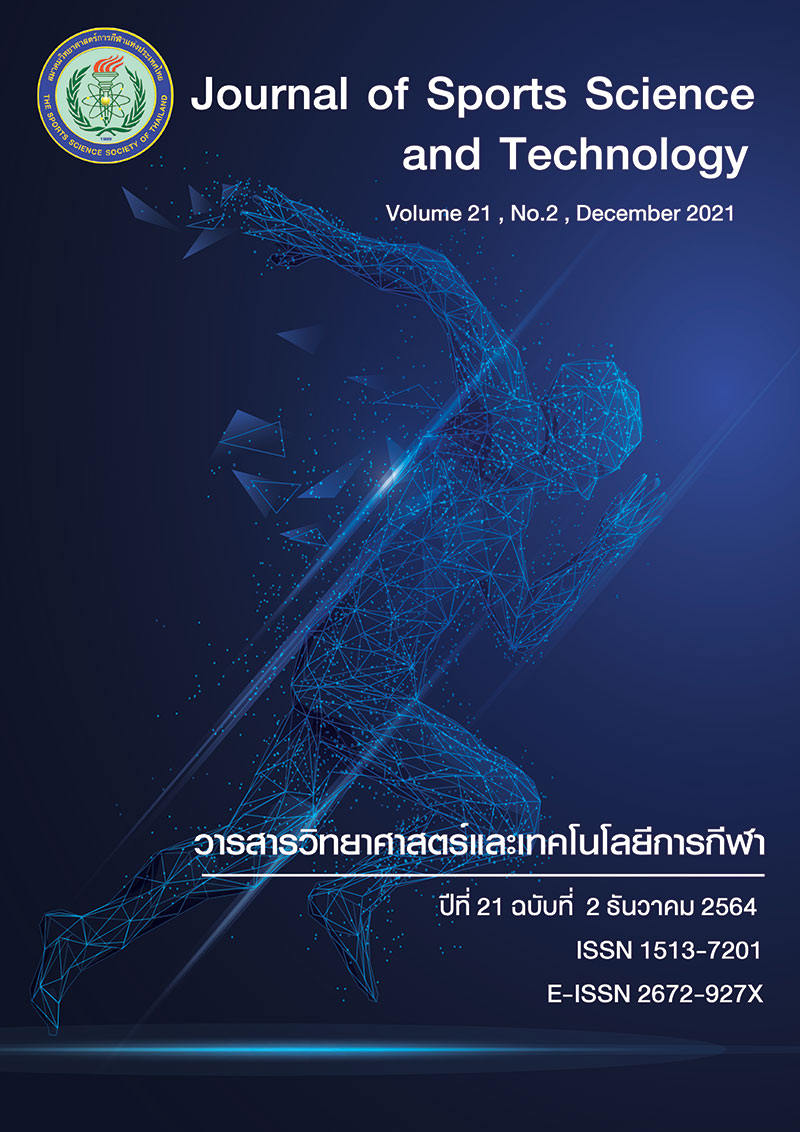EFFECTS OF ELASTIC RESISTANCE AND BODY WEIGHT TRAINING PROGRAM ON UPPER AND CORE BODY MUSCLE STRENGTH IN ARCHER
DOI:
https://doi.org/10.14456/jsst.2021.11Keywords:
Elastic resistance and body weight training, Upper body muscle, Core body muscle, ArcheryAbstract
The purpose of this research was to study the effect of an elastic strength training program and body weight on the upper and core body muscle strength in archery athletes. Participants were archery athletes of Thailand National Sports University who have experienced in national and international competition with over 2 years (average age 20.93±2.19 years old). A total of 30 participants was divided into 2 groups using systematic sampling method. An experimental group was performed a strength training program with elastic band and body weight for 60 minutes alongside with a routine training whereas a control group was practiced only a routine training program for 90-120 minutes a day, 3 days /week for 8 weeks. The upper and core body muscles strength were assessed at prior and after 4 and 8 weeks of training, respectively. Within group comparison was tested using a repeated measures ANOVA whereas between-group comparison was analyzed using one-way ANOVA. A significant difference was set at P-value <0.05. The results indicated that an average of upper and core body muscles strength was increased when compare before training in both groups. The upper body muscle strength value (Grip strength test and 30-Second push up test) was significantly higher in the experimental group after the 4 and 8 weeks of training (p<0.05) while it was significantly higher in the control group at 8 weeks after training (P<0.05). The core body strength (Core strength and stability test) values were significantly higher in the experimental group and significant difference from the control group (P<0.05) after 4 and 8 weeks of training program. In conclusion, the elastic and bodyweight strength training program can increase core muscles strength when compare to a regular routine training. Therefore, coaches or archers can apply elastic resistance and body weight training program to improve core muscle strength. In addition, an intensity of upper body training is a variable to be considered for the archery training in order to increase the upper body muscle strength of archery athletes.
(Journal of Sports Science and Technology 2021; 21 (2):60-73)
(Received: 28 April 2021 , Revised: 24 August 2021, Accepted: 25 August 2021)
*Corresponding Author: Nonthalee SANTINIYOM
Faculty of Sports and Health Science, Thailand National Sports University Sukhothai Campus,Sukhothai, 64000, THAILAND.
E-mail: i.nonthalee@gmail.com
References
2. Lin J-J, Hung C-J, Yang C-C, Chen H-Y, Chou F-C, Lu T-W. Activation and tremor of the shoulder muscles to the demands of an archery task. J Sports Sci 2010;28:415-21.
3. Bebetsos E. Psychological skills of elite archery athletes. J Hum Sport Exerc 2015;10:623-28.
4. Sriramatr S. หลักการฝึกกีฬาสำหรับผู้ฝึกสอนกีฬา.5th ed. Bangkok: Chulalongkorn university printing house; 2017.
5. Justin S, Thomas WN, Timothy JD, David M. Effect of core strength on the measure of power in the extremities. J Strength Cond Re 2012;26:373-380.
6. Hibbs AE, Thompson KG, French D, Wrigley A, Spears I. Optimizing performance by improving core stability and core strength. Sports Medicine 2008;38:995-1008.
7. Jeffrey H. Bodyweight training: a return to basics. Strength Cond J 2010;32:52-5.
8. Chuanchaiyakul R, Sarasasmita S, Pinthong M, Chentanez T. Changes in muscle strength and anaerobic performance following elastic band training in youth wrestlers. J Sports Sci Technol 2016;2:33-44.
9. Krejcie RV, Morgan DW. Determining sample sizes for research activities. Educ Psychol Meas 1970;30:607-10.
10. Mackenzie B. Performance evaluation tests[Internet]. 2005 [cited 2020 Jan]. Available from https://www.brianmac.co.uk/eval.htm.
11. Kanjanawasee S. Classical test theory. 5th ed. Bangkok: Chulalongkorn University; 2001.
12. Streiner DL, Norman GR. Health measurement scales: a practical guide to their development and use. 2nd ed. United Kingdom: Oxford University Press; 1995.
13. Srisa-ard B. การวิจัยเบื้องต้น. 8th ed. Bangkok: Suweeriyasan; 2010.
14. Juliana N, Roslan NA, Hayati AR. Muscle strength in male youth that play archery during leisure time activity. Proceedings of the 2019 Movement, Health & Exercise (MoHE) and International Sports Science Conference (ISSC); 2019; Springer Nature Singapore Pte Ltd.
15. Clarys JP, Cabri J, Bollens E, Sleeckx R, Taeymans J, Vermeiren M, et al. Muscular activity of different shooting distances, different release techniques, and different performance levels, with and without stabilizers, in target archery. J Sports Sci 1990;235-57.
16. Krabuanrat CH. การฝึกกล้ามเนื้อโดยการยกน้ำหนัก. Bangkok: Department of physical education and sports Kasetsart university; 2001.
17. Jantaraj N. Effect of core muscle strength training on dynamic balance of Chiang Mai university demonstration school football player, Chiang Mai: Chiang Mai university; 2012.
18. Szymski D, Seiffert R. Archery and shooting sports. Injury and health risk management in sports 2020:705-09.






